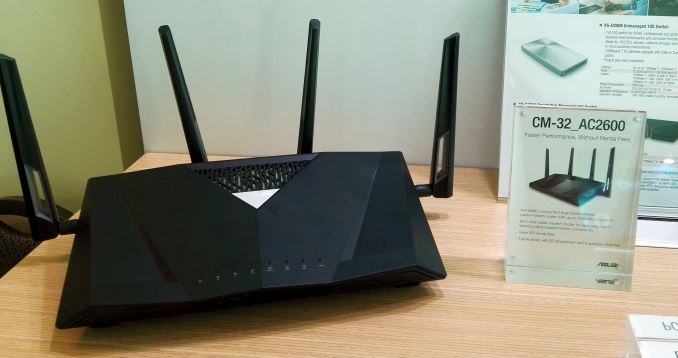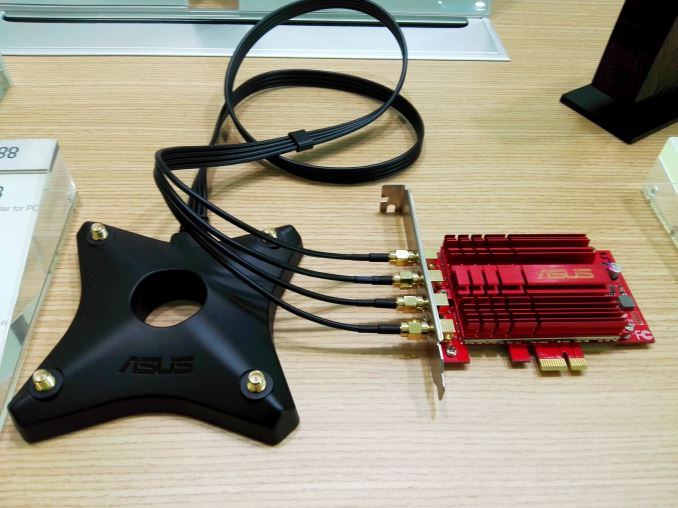ASUS Booth Tour at CES 2016: 10G Switches, External GPU Dock, USB-C Monitor and more
by Ian Cutress on January 19, 2016 9:00 AM ESTAside from the 10GBase-T switches written about earlier (they were actually hidden more in the B2B part of ASUS’ booth complex), the march on wireless is still one of ASUS’ marketing angles. Anyone who has looked into new routers or WiFi connection points can’t help but have noticed the swathe of ASUS routers now available, from single stream 802.11n USB sticks all the way up to 4x4 dual band 802.11ac MU-MIMO capable hardware.
Networking
ASUS had on display the AC2600 cable modem router, which offers 4x4 MIMO support, which can provide better coverage than the current generation of 3x3 models. I find it mildly interesting that it lists up to 2.53 Gbps support, although this will be shared between connected units and the gigabit Ethernet network ports on the rear might be a bottleneck to peak speed. That being said, the only time peak speed would be needed is for file transfer or multiple streaming.
To go with this, because there are no 4x4 on-motherboard solutions currently out, ASUS also had a PCIe wireless networking card which supports 4x4 802.11ac for up to 3.1 Gbps theoretical speed.
ASUS put a big heatsink on this card to help it keep cool under load, and the unit is massive. That being said, similar to other ASUS units, it is magnetic and thus will allow most users to affix it to the top or side of the PC chassis. Ultimately this is aimed at being the peak solution for when wires can’t make it.
Also on display was what ASUS was calling the first USB 3.0 based dual-band AC1900 WiFi point, capable of 3x4 MIMO and a flexible cable. In the USB format, this can be moved from machine to machine as well as not taking up a PCIe 3.0 x1 port on the motherboard. No word on pricing or release date at this time.













50 Comments
View All Comments
DanNeely - Tuesday, January 19, 2016 - link
Is the back of that phone actually made up of a bunch of triangular panels at angles to each other; or does the finish just fake the look?WorldWithoutMadness - Tuesday, January 19, 2016 - link
It is 3D (source http://www.androidcentral.com/hands-asus-zenfone-2...Panzerknacker - Tuesday, January 19, 2016 - link
I just dont understand why did 10G never become mainstream and is it so damn expensive? Back when 100mbit was mainstream the price of 1G was higher but nowhere near $760 for a switch. 1g is now mainstream for a decade or so, what takes it so long? Did we reach the limit of copper networking? I mean, in datacenters there has to be a enormous market for fast networking, I cannot understand why prices are still so high because on a huge market you would expect a lot a competition and fast development of hardware. Or did they completely move to different networking standards in datacenters, like fibre?Reflex - Tuesday, January 19, 2016 - link
Power consumption is very high compared to gigabit, and wireless replaced ethernet for most home and small office use, thus negating economies of scale which normally would drive prices down.Lieuchikaka - Thursday, June 2, 2016 - link
http://mavangvn.vn/ma-vang-dien-thoai/dien-thoai-s...TwistedKestrel - Tuesday, January 19, 2016 - link
It's mostly the ubiquity of 1GbE vs the handful of vendors making 10GbE parts. 1GbE PHYs are cheap as dirt, and 10GbE is two orders of magnitude more expensive... and there aren't that many people that want it yet. Once 1Gb+ throughput on 802.11ac radios becomes more commonplace instead of mostly theoretical, that would be something of a driver for consumer 10GbE.Interesting that a few US ISPs have upcoming or available service in excess of 1Gb, I wonder what kind of connections their equipment would have
DanNeely - Tuesday, January 19, 2016 - link
For consumer service, I'd be really surprised if it was anything but a combined modem/pretend it actually is able to achieve multi-gigabit speeds wifi router.iwod - Tuesday, January 19, 2016 - link
They have new standard NBase-T which provides 2.5Gbps and 5Gbps on Normal CAT 6 Cable. But no idea why no company are getting products out.Alex_M - Wednesday, January 20, 2016 - link
The real benefits for NBase-T will be 2.5/5 Gbps over exisitng Cat5e (not Cat6) upto 100m. It means we don't have to replace all those existing cable runs to benefit from the higher speed. Its fairly new but I hear that the silicon has started sampling....Lieuchikaka - Thursday, June 2, 2016 - link
http://mavangvn.vn/ma-vang-dien-thoai/dien-thoai-s...